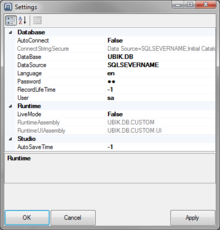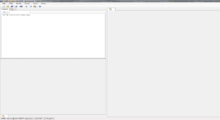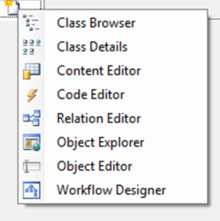Difference between revisions of "UBIK Studio Basics"
(→Admin mode) |
(→Using and connecting controls) |
||
| Line 140: | Line 140: | ||
! Control !! Purpose | ! Control !! Purpose | ||
|- | |- | ||
| − | | ''[[Class Browser]]''|| Navigate through | + | | ''[[Class Browser]]''|| Navigate through, create and delete MetaClasses and instances |
|- | |- | ||
| − | | ''[[Class Details]]''|| Design MetaClasses | + | | ''[[Class Details]]''|| Design MetaClasses in their details |
|- | |- | ||
| − | | ''[[Bulk Editor]]''|| Create and edit instances | + | | ''[[Bulk Editor]]''|| Create and edit multiple instances of a MetaClass in table style |
|- | |- | ||
| − | | ''[[Code Editor]]''|| Implement | + | | ''[[Code Editor]]''|| Implement MetaClass specific functionality using C# |
|- | |- | ||
| − | | ''[[Relation Editor]]''|| Relate objects and edit relational data | + | | ''[[Relation Editor]]''|| Relate objects to each others and edit relational data |
|- | |- | ||
| ''[[Object Explorer]]''|| Display and edit all exposed properties of objects (list style) | | ''[[Object Explorer]]''|| Display and edit all exposed properties of objects (list style) | ||
|- | |- | ||
| − | | ''[[Object Editor]]''|| | + | | ''[[Object Editor]]''|| Edit the property values of a single object |
|- | |- | ||
| ''[[Workflow Designer]]''|| Design and assign customer specific workflows | | ''[[Workflow Designer]]''|| Design and assign customer specific workflows | ||
Revision as of 14:06, 4 April 2013
UBIK® Studio is the server application and administrative tool for creating and modifying UBIK® object models. Transfer your entitiy-relationship-model into UBIK® MetaClasses and MetaProperties and build up necessary relations. It is also the instrument of your choice to manage instances of MetaClasses, edit their property values and create actual relations between instance objects. This section will provide you with more information on the user interface.
Contents
Prerequisites
Options
Locate and click the menu Edit → Options. Press Apply or OK when you're finished changing the settings, or Cancel if you don't want your changes to be saved. The settings are user-specific and will be stored in your local Windows user profile.
In the options you can configure your database connection by the following parameters
| Parameter | Purpose |
|---|---|
| AutoConnect | If set to true, the system will attempt to automatically connect to the configured database on start up |
| DataBase | The name of your SQL Server |
| DataSource | SQL server instance (specify a server via host name, UNC, IP, ...) |
| Language | Set the desired database language in ISO639-1 syntax |
| User | SQL user name |
| Password | SQL user password |
Take care that the specified SQL user has appropriate permissions on the database.
Additional options are
| Parameter | Purpose |
|---|---|
| LiveMode | Use the relational database structure (true) or the Sandbox structure (false) |
| RecordLifeTime | Set how long records are valid before they will be requeried for changes by the kernel; -1 to turn off |
| AutoSaveTime | Set how often UBIK® Studio should save all unsaved objects automatically, in minutes; -1 to turn off |
Command line arguments
The following arguments can be passed to and will be recognized by the UBIK.Studio.exe:
| Parameter | Purpose |
|---|---|
| -NOCUSTOM | Don't attempt to load the customized object code |
| -NOCUSTOMUI | Don't attempt to load the customized UI elements |
| -CUSTOMVERSION:version | Attempt to load a specific deployed version of the customizing instead of the currently released one. Use this option if you want to test a specific customizing, without releasing it to all users. |
| Setting these command line argument might changes the expected behavior of a data model significantly! |
Working with UBIK® Studio
Basic UI elements
Menu and toolbar
The top area of UBIK® Studio features a menu strip:
| Menu | Menu item | Shortcut | Purpose |
|---|---|---|---|
| File | New | Ctrl+N | No purpose yet |
| Open Database | - | Clicking the item itself will attempt to open the last configured database connection, its sub menu items will show the most recently used connections | |
| Clear recent list | - | Clears the list of recently used database connections | |
| Save All | Ctrl+S | Saves all unsaved objects of the current session to the database | |
| Exit | - | Closes UBIK® Studio | |
| Edit | Options... | - | Opens the settings dialog |
| Build | Rebuild... | F6 | Assembles the entire customizing code and display the result in a preview window |
| Rebuild and download... | Ctrl+F6 | Assembles the entire customizing code and attempts to deploy it according to the current database settings | |
| Tools | Customize | - | No purpose yet |
| View Test Environment... | - | Opens the View Test Environment window | |
| Interface Manager... | - | Opens the Interface Manager window | |
| Who-Bert, the debugging opossum... | - | Opens the Who-Bert window | |
| View | New Working Window | Ctrl+W | Opens a new working window to host additional controls |
| Unsaved Objects Hierarchy | Ctrl+U | Opens a window showing all currently changed, yet unsaved objects in a hierarchical style | |
| Help | UBIK Wiki | - | Opens the UBIK® Wiki, meaning the root of this document |
| UBIK Class Documentation | - | Opens the help file with the UBIK® Class Documentation |
Status strip
The very bottom of the UBIK® Studio window displays a status strip, providing the following information, from left to right:
| Initial value | Purpose |
|---|---|
| DB | Current database: once connected, it will show the connection in the format Instance@Server |
| NOT INITIALIZED | Current Customizing: when successfully loaded, it will display the version information of the instantiated customizing assembly, -1.-1.-1 if loading failed |
| CULTURE | Current language and culture in ISO639-1 format |
| SESSION | Displays the name of the Login of the current Session; Right click on this item to switch into Admin mode |
Working area and controls
The main window of UBIK® Studio is split into 3 sections, where each of the 3 areas can hold an arbitrary amount of controls. The arrangement of the controls is user specific and can be saved in the user's profile. In addition to the predefined sections, the user interface can be extended with working windows, where each working window can again hold any amount of controls:
- View → New Working Window or Ctrl+W
However, such working windows are considered temporary and are therefore not made persistent when the layout is saved.
Using and connecting controls
Each control provides different functionality for object creation/modification. Clicking the header of an empty tab strip in one of these areas with the left mouse button will bring up a context menu, that allows you to create a new tab page hosting one of the following controls:
| Control | Purpose |
|---|---|
| Class Browser | Navigate through, create and delete MetaClasses and instances |
| Class Details | Design MetaClasses in their details |
| Bulk Editor | Create and edit multiple instances of a MetaClass in table style |
| Code Editor | Implement MetaClass specific functionality using C# |
| Relation Editor | Relate objects to each others and edit relational data |
| Object Explorer | Display and edit all exposed properties of objects (list style) |
| Object Editor | Edit the property values of a single object |
| Workflow Designer | Design and assign customer specific workflows |
All controls in the UBIK® working area offer the following interaction functionality:
- Set a control as ListenTo source of another control by dragging an object from it with the left mouse button and dropping it to the header of the hosting tab of the target control
- Perform the same procedure with the right mouse button to only set the context object of the target control, but not its ListenTo source
- Release ListenTo by clicking the respective header and selecting the ListenTo: control name menu item
- Reconnect to the last ListenTo source by selecting the Reconnect to: control name menu item
- Close a control by right clicking the tab header and selecting the Close menu item.
User rights
As of now, UBIK® Studio doesn't feature a real user management system for designing data models. Although there is a distinction made between an admin and a non-admin user, with the very purpose of protecting system objects against unintended manipulation.
However, UBIK® fetches the current Windows user and creates the environment with this credentials, storing the login information on a Session object.
Admin mode
Right click on the user name in the status strip and select the menu item Admin mode to switch all active controls to Admin mode. As long as you are in admin mode, the user name in the status strip will appear red.
| Be careful, manipulating system objects might results in instability of UBIK® Studio or other UBIK® components! |



